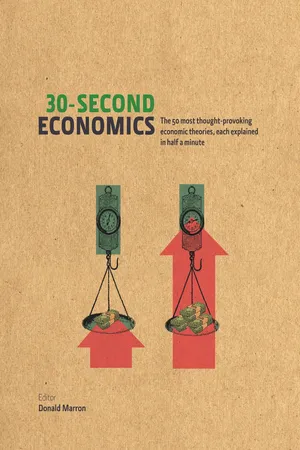![]()
ECONOMIC CYCLES
![]()
ECONOMIC CYCLES
GLOSSARY
aggregate demand The total demand for goods and services within an economy at a certain time. This can be influenced by government either through monetary policy (that is, controlling the amount of money in the economy through interest rates and other means) and/or fiscal policy (that is, increasing/decreasing the amount of government expenditure).
balance of payments The difference between the total spent on goods and services imported from overseas and the amount earned from goods and services sold overseas. Countries often aim to export more than they import, to give them a balance of payments surplus. Since the early 1980s, however, the United States has run a balance of payments deficit of up to 6 percent of gross domestic product (GDP) without grinding to a halt.
credit crunch A restriction on the availability of credit, or loans. This is often the result of a loss of confidence in a sector of the finance market, leading to investors withdrawing their funds to invest in a safer option.
expansionary policies If an economy is in recession, a government may adopt expansionary policies to attempt to reinvigorate it. These can include monetary policies, such as reducing interest rates and buying bonds to increase the amount of money in the system. They can also include fiscal policies, such as investing heavily in public services, building projects, or cutting taxes.
inflation The increase in the price of goods and services over a given period of time, usually measured using the Consumer Price Index. A small amount of inflation is generally regarded as acceptable because it helps to smooth relative price adjustments in the economy. Very high inflation, however, leads to instability in the financial markets and worker unrest as the real value of wages drops.
money supply This refers to the total amount of money in circulation within an economy at a given point in time. This can be controlled by central government partly by raising or lowering interest rates—high interest rates usually means less money in the system; low interest rates means more—but also through other policies, such as the purchase of long-term bonds, to inject a quantity of cash (known as “quantitative easing”).
“Ponzi” borrower A person who takes out a loan to buy an asset and is dependent on the appreciation (increase in value) of that asset to pay off the interest and original sum of the loan. The term was invented by Hyman Minsky and contrasts with other types of borrowers who repay debts using moneys earned from investments. The Ponzi type of borrower was quite common right before the 2007 subprime crisis, as the spiraling price of property lulled buyers into thinking they could pay off their debts using the equity in their houses.
private sector That part of the economy owned and run by individuals and corporations mostly (but not always) for profit.
public sector That part of the economy owned and run by the state. Typically, this will include provision of social security, education, defense, public transport, and certain utilities. These may or may not be run for profit.
stagflation Literally, a combination of stagnation and inflation. Until the 1970s, most economists believed it was impossible to have both at the same time, and much of Keynesian theory was based on this assumption. The advent of stagflation in the 1970s meant that governments could no longer spend their way out of recession without risking unacceptably high inflation. As a result, Keynesian policies were marginalized for the next three decades.
supply-siders Those who believe that economic prosperity is dependent on creating the best conditions possible for the suppliers of products and services (that is the employers). Thus, regulation should be kept to a minimum and corporate taxes should be as low as possible. Demand-siders believe that empowering workers and encouraging them to consume more creates demand for products, which in turn stimulates industry and creates employment. Thus, governments should invest in educating and creating opportunities for workers and ensuring they get a fair deal from employers through employment legislation.
![]()
KEYNESIAN ECONOMICS (NORMATIVE)
the 30-second theory
John Maynard Keynes diagnosed the Great Depression as a failure of aggregate demand: People didn’t want to spend, and so the world economy spiraled downward. His prescription? The government should boost aggregate demand. In particular, it should boost its own spending to fill the gap in aggregate demand from the private sector. By spending on new projects, making transfers to people in need or cutting taxes, the government could boost demand. Firms would then employ more workers to produce more. Those workers would spend their paychecks, and you would have a virtuous cycle of growth that would get the economy out of the recession and reduce unemployment. Keynesianism became the most popular economic doctrine of the “golden age” of capitalism (1945–1973). The key idea was that governments have to intervene in the economy to ensure full employment; if the rate of unemployment was left to the free market, it would naturally run much higher. Government intervention took the form of public spending, tax cuts for workers, and transfer payments.
3-SECOND CRASH
The government should spend and cut taxes to soften economic downturns.
3-MINUTE BOOM
Keynesianism seemed to be the cure to capitalism’s problems. For 30 years, growth rates were high and most people had a job—in the West at least. But in the 1970s there was stagflation and government spending couldn’t make things better. The monetarists attacked Keynesians, suggesting that governments had overexpanded the money supply, so creating inflation. Supply-siders pointed out ...

